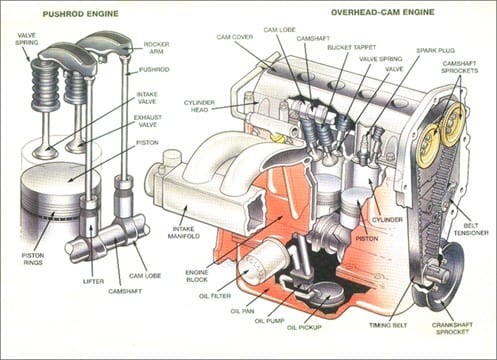Just like the human body needs various organs to function, a car engine relies on numerous components working in perfect harmony to power your vehicle. At its core, the engine’s job is to convert fuel energy into motion through a series of controlled combustions. While often viewed as a single unit, a car engine is actually a complex assembly of individual parts, each with a specific role. Knowing the names and functions of these Parts Of A Car Engine is crucial for understanding how your vehicle operates and how to maintain it properly. Let’s delve into the essential components that make your engine tick.
 Diagram of a car engine and its parts
Diagram of a car engine and its parts
Car engines are built around strong, sealed metal cylinders. Modern cars typically house between four and eight cylinders, and in some high-performance vehicles, this can go up to sixteen. These cylinders are designed to open and close at precise moments, allowing fuel to enter, mix with air, and ignite, and then to expel the resulting exhaust gases. Among the many parts of a car engine, some are more critical than others for its fundamental operation. Here’s a breakdown of the key components and their functions, as illustrated in the diagram above.
Key Components of Your Car Engine
Engine Block
The engine block is the foundation of your engine. Usually made from aluminum or iron, this robust structure contains the cylinders and features pathways for coolant and oil to circulate, keeping the engine lubricated and at the right temperature. Oil passages are smaller than coolant passages. The engine block also provides housing for vital parts of a car engine such as the pistons, crankshaft, and camshaft, and accommodates the cylinders – typically four to twelve – arranged in inline, flat, or V configurations depending on the vehicle.
Pistons
Pistons are cylindrical parts with a flat top surface that move up and down inside the cylinders. Their main function is to transfer the force from combustion to the crankshaft, which ultimately powers the wheels. In each crankshaft rotation, a piston travels up and down twice within its cylinder. Imagine an engine rotating at 1250 RPM; the pistons are moving up and down an astounding 2500 times every minute. Piston rings, located within the piston, are essential parts of a car engine that help maintain compression and minimize friction against the cylinder walls.
Crankshaft
Located in the lower part of the engine block, within crankshaft journals that rest on bearings, is the crankshaft. This precisely engineered and balanced component is connected to the pistons via connecting rods. The crankshaft is a crucial part of a car engine because it converts the linear up-and-down motion of the pistons into a rotational motion, which is then used to drive the vehicle’s transmission and wheels. It works similarly to a jack-in-the-box mechanism, transforming reciprocating motion into rotary motion at engine speed.
Camshaft
The camshaft’s location can vary depending on the vehicle model, sometimes found within the engine block or in the cylinder heads. Many modern engines utilize cylinder heads for camshaft placement, often employing Dual Overhead Camshaft (DOHC) or Single Overhead Camshaft (SOHC) configurations. These are supported by bearings lubricated with oil for durability. The camshaft is a vital part of a car engine responsible for regulating the timing of valve opening and closing. It takes rotational motion from the crankshaft and converts it to an up-and-down motion, controlling lifters, pushrods, rockers, and ultimately, the valves.
Cylinder Head
Attached to the engine block with cylinder bolts and sealed by a head gasket, the cylinder head is another critical part of a car engine. It houses numerous components, including valve springs, valves, lifters, pushrods, rockers, and camshafts. The cylinder head manages the passageways that allow intake air to enter the cylinders during the intake stroke and exhaust gases to exit during the exhaust stroke. The head gasket itself is essential for maintaining a seal between the engine block and cylinder head, preventing leaks of coolant and combustion gases.
Timing Belt/Chain
To ensure the engine runs smoothly, the camshaft and crankshaft must be synchronized, and this is achieved by the timing belt or chain. This part of a car engine ensures precise timing for all internal processes. The timing belt is constructed from durable rubber with cogs that grip pulleys on the camshaft and crankshaft. A timing chain, similar to a bicycle chain, wraps around toothed pulleys to achieve the same synchronization. Proper function of the timing belt/chain is crucial for valve timing and overall engine performance.
Common Engine Issues
Given the complexity and high-speed operation of these parts of a car engine, wear and tear over time is inevitable, and this can lead to various engine problems. Here are some common issues and their symptoms:
- Poor Compression: This can lead to reduced engine power, misfires, or the engine failing to start.
- Cracked Engine Block: Overheating, exhaust smoke, or coolant leaks, often visible on the engine’s exterior, can indicate a cracked engine block.
- Damaged Pistons, Rings, or Cylinders: Rattling noises, blue exhaust smoke, rough idling, or failing emissions tests are potential signs of damage to these components.
- Broken or Worn Rods, Bearings, and Pins: Tapping or ticking sounds, low oil pressure, metal particles in the engine oil, or rattling during acceleration can suggest issues with these parts of a car engine.
Car engines might seem intricate, but their fundamental purpose is straightforward: to propel your car. With so many parts of a car engine working together to create motion, regular vehicle maintenance is essential for ensuring their longevity. Following recommended schedules for oil changes, fluid flushes, and replacing belts and hoses can significantly help in preventing major engine failures. Understanding these core components and paying attention to your car’s maintenance needs will contribute to a reliable and long-lasting engine.
